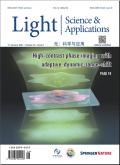用于矢量结构光不可分性测量的相干探测器。
IF 23.4
Q1 OPTICS
引用次数: 0
摘要
在自由空间光通信系统中,大气湍流会使光的复杂波前发生畸变,导致误码甚至通信中断。近年来研究发现,矢量结构光的不可分性在穿越大气湍流时保持不变。这一发现为基于矢量结构光的不可分离性的湍流弹性通信编码提供了一个潜在的解决方案。为了实现这种抗湍流通信,有效检测矢量结构光的不可分离性是必不可少的,它作为这种通信系统的接收器。到目前为止,传统的不可分离性检测方案通常依赖于笨重的slm或dmd,面临着单次射击能力和系统紧凑性之间的固有权衡。此外,矢量叠加态的模式分辨不可分性贡献的检测尚未完成。本文提出并实验证明了一种基于离轴数字全息的矢量结构光不可分性检测方法,克服了传统方法对空间模式进行数字分解的局限性。我们的方法可能为基于不可分性编码方法的湍流弹性光通信铺平道路,并为不可分性测量带来新的见解。本文章由计算机程序翻译,如有差异,请以英文原文为准。
Coherent detector for the non-separability measurement of vectorial structured light.
Atmospheric turbulence distorts the complex wavefront of light in free-space optical communication systems, leading to bit errors and even communication interruptions. Recently, it is found that the non-separability of vectorial structured light remains invariant when transmitting through atmospheric turbulence. This discovery offers a potential solution for turbulence-resilient communications-encoding based on the non-separability of vectorial structured light. To achieve such turbulence-resilient communications, efficient detection of the non-separability of vectorial structured light is essential, which acts as the receivers of such communication systems. So far, traditional non-separability detection schemes usually rely on bulky SLMs or DMDs, facing inherent trade-offs between single-shot capability and system compactness. In addition, the detection of mode-resolved non-separability contributions of vectorial superposition states has not yet been accomplished. Here, we propose and experimentally demonstrate a coherent detector to characterize the non-separability of vectorial structured light based on off-axis digital holography, which overcomes the limitations of traditional approaches by digitally decomposing spatial modes. Our approach may pave the way for turbulence-resilient optical communications based on non-separability coding methods and bring new insights into non-separability measurement.
求助全文
通过发布文献求助,成功后即可免费获取论文全文。
去求助
来源期刊

Light-Science & Applications
数理科学, 物理学I, 光学, 凝聚态物性 II :电子结构、电学、磁学和光学性质, 无机非金属材料, 无机非金属类光电信息与功能材料, 工程与材料, 信息科学, 光学和光电子学, 光学和光电子材料, 非线性光学与量子光学
自引率
0.00%
发文量
803
审稿时长
2.1 months
 求助内容:
求助内容: 应助结果提醒方式:
应助结果提醒方式:


